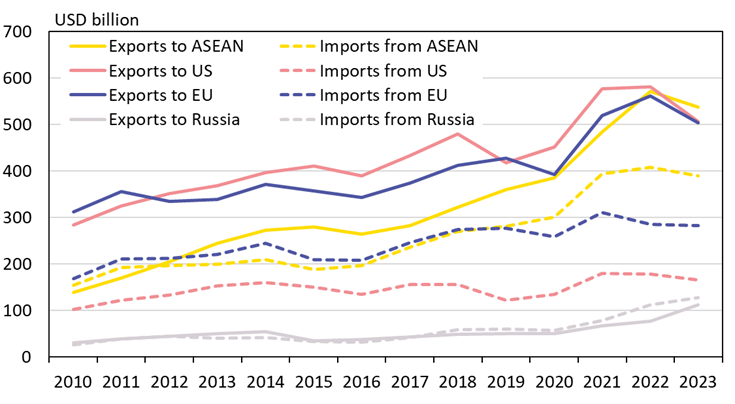BOFIT Weekly Review 4/2024
Despite China’s overall weak foreign trade performance last year, trade with Russia boomed
China Customs valued the country’s goods exports last year at 3.38 trillion dollars and goods imports at 2.56 trillion dollars. Both exports and imports values were down by about 5 % y-o-y. Factors depressing growth included weakness in the global economy and China’s own economy, increased geopolitical tensions, as well as changes in prices and exchange rates. Available data suggest a slight increase in export and import volumes last year. China again posted a massive goods trade surplus in 2023 –820 billion dollars.
Trade trends bifurcate at the country level. The value of China’s exports and imports contracted with respect to most Western and ASEAN economies. Among China’s other large trading partners, exports soared to Russia. Since Western firms pulled out of Russia due to the war on Ukraine and sanctions on Russia, Chinese firms have enjoyed a wide-open market. The value of Chinese exports to Russia last year rose by nearly 50 %, elevating Russia to China’s 8th largest trading partner and accounting for slightly over 3 % of China’s total exports. China’s exports to Central Asia also experienced rapid growth, with some of those exports possibly continuing on to Russia. The value of vehicle exports to Russia tripled, making it the highest growth category in Chinese exports to Russia. The value of exports machinery & equipment was also up by nearly 50 %.
The value of Chinese imports from Russia increased, but more slowly than exports (10 %). China’s imports from Russia largely consist of energy products, so changes in global energy markets translate directly to the value of imports. Energy prices overall declined last year, while growth of energy import volumes was impressive. Imports of oil were up by 24 % y‑o‑y, refined oil products by 170 %, coal by 50 % and liquefied natural gas by 24 %. In addition, the volume of gas supplied by pipeline appears also to have increased considerably. Russia has emerged as China’s largest supplier of oil, accounting for 19 % of the volume of total oil imports last year. Saudi Arabia was the China’s second largest supplier, accounting for 15 % of import volumes. Chinese buyers are attracted by the discounts on Russian oil. According the China Customs figures, imported Russia oil carried an 8 % discount with respect to the average of all other imported crude. With respect to other imports, Russia has kept in place the raw wood export bans that came into effect in early 2022 even for China (see BOFIT Weekly 41/2020).
Observers expect 2024 to be a tough year for Chinese foreign trade. Growth of the global economy is predicted to be subdued, geopolitical tensions high and companies forced to continually evaluate and adjust their supply and production chains. Chinese exporters also may find it difficult to grow its market share in Russia at the same pace as last year. The recent Red Sea insecurity has lengthened freight shipping times to Europe and China’s weak economy is dragging down import demand.
Trends in Chinese goods trade with select trading partners
Sources: China Customs, CEIC and BOFIT.